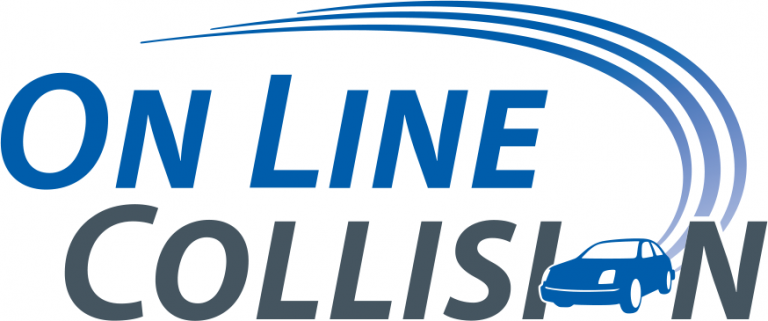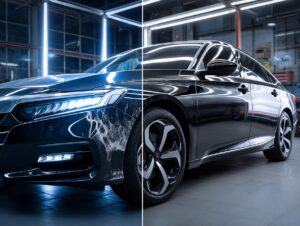Preserve your car’s finish with fast, eco-friendly dent repair.
What is Paintless Dent Repair (PDR)?
Paintless Dent Repair (PDR) is a specialized method for removing minor dents and dings from a vehicle’s body without disturbing the original paint. PDR technicians use specialized tools to carefully manipulate the dented area from the inside, restoring the panel’s shape without the need for repainting.
PDR is a preferred choice for many car owners due to its efficiency, cost savings, and ability to preserve the vehicle’s factory finish. Unlike traditional repair methods, PDR avoids fillers and paint, making it a sustainable and visually seamless option.
For more insights into our automotive repair processes, visit On Line Collision’s automotive paint repair page.
The Benefits of PDR
Cost Efficiency
PDR typically costs significantly less than traditional body repair methods. Because it doesn’t involve repainting or extensive labor, it saves on both material and time, making it a budget-friendly option for minor damage.
Time-Saving
Since PDR does not require paint matching or waiting for paint to dry, the process can often be completed in just a few hours. This quick turnaround minimizes disruption to your schedule.
Eco-Friendly Solution
PDR eliminates the need for fillers, solvents, and paint, reducing the environmental impact. It’s an excellent choice for eco-conscious car owners who want to minimize their carbon footprint.
Maintains Original Paint
Keeping your car’s original paint intact preserves its aesthetic appeal and resale value. PDR avoids mismatched paint colors, maintaining the factory finish for a flawless appearance.
For more on maintaining your vehicle’s look and value, explore our collision repair services.
When Is PDR Suitable?
Minor Dents and Dings
PDR is ideal for small dents caused by minor impacts. If the paint remains intact and the damage is not too deep, PDR can restore the panel to its original condition.
Hail Damage
Hailstorms often leave small, round dents that are perfect candidates for PDR. Since these dents rarely crack the paint, they can be removed quickly and efficiently.
Parking Lot Incidents
Accidental bumps in parking lots can cause dents that are easily managed through PDR. These are often on doors or fenders and do not compromise the car’s paintwork.
Door Dents
Door dings from adjacent vehicles are common and can usually be fixed using PDR, keeping your car looking as good as new.
How Does PDR Work?
Assessment and Planning
The first step involves inspecting the dent to determine the best approach. Technicians assess the dent size, location, and depth.
Specialized Tools and Techniques
Using precision tools, technicians gently massage the dent from behind the panel, carefully restoring the original contour without damaging the paint.
Precision Repair Process
The process requires patience and expertise. Technicians use LED lighting to visualize the dent and work meticulously to ensure a smooth, dent-free finish.
For more about our precise repair techniques, check out our automotive structural repair services.
Choosing a PDR Professional
Certification and Experience
Look for technicians with I-CAR Gold Class Certification, indicating advanced training in collision repair.
Reviews and Recommendations
Check customer reviews and ask for recommendations to ensure quality service.
Guarantee and Warranty
A reputable shop will stand by its work, offering warranties on PDR services.
For certified and trustworthy repair, visit OnLine Collision’s certification page.
FAQs
1. Can all dents be fixed with PDR?
Not all dents are suitable for PDR. This method works best for minor dents, dings, and creases where the paint has not been cracked or chipped, and the metal is not severely stretched. Dents from hail, door dings, and minor collisions are often ideal candidates. However, if the dent is deep, sharp, or has compromised the paint, more traditional repair methods may be necessary. To find out if your dent qualifies, it’s best to consult with a certified PDR technician, like those at On Line Collision, who can assess the damage accurately.
2. Does PDR affect my car’s warranty?
No, PDR typically does not affect your car’s manufacturer warranty. In fact, many manufacturers recommend PDR as it preserves the original paint and finish, maintaining the vehicle’s structural integrity and warranty. Be sure to confirm this with your car manufacturer or dealership to be certain. At On Line Collision, our certified technicians follow the industry’s highest standards, ensuring your vehicle’s warranty remains intact.
3. How long does PDR take?
PDR is significantly faster than traditional dent repair methods. Minor dents can often be fixed within a few hours, while more complex repairs may take a day or two, depending on the extent of the damage. This quick turnaround minimizes your vehicle’s downtime, allowing you to get back on the road faster. To schedule a PDR service, contact On Line Collision.
4. Is PDR covered by insurance?
Yes, many insurance companies cover PDR, especially for hail damage and minor collision repairs. It’s generally seen as a cost-effective and quality-preserving option, making it a preferred choice for both insurers and vehicle owners. However, coverage can vary, so it’s important to check with your insurance provider or consult a professional at On Line Collision for guidance.
5. Can I do PDR myself?
While DIY PDR kits are available, they often lack the precision tools and expertise required for professional results. Without proper training, you risk causing further damage to the vehicle, potentially leading to more costly repairs. For the best results, it’s recommended to leave PDR to certified technicians like those at On Line Collision.
6. What factors affect PDR success?
Several factors can influence the success of PDR, including the size, location, and depth of the dent, as well as the flexibility of the metal. Aluminum panels, for example, are more challenging to work with than steel. Additionally, the condition of the paint and the accessibility of the dent from behind the panel are critical. For a proper assessment, contact On Line Collision to speak with a certified technician.
7. How do I know if PDR is right for my car?
PDR is ideal for vehicles with minor, shallow dents that haven’t cracked the paint. It’s also a great option if you want to maintain your vehicle’s resale value and avoid the more invasive methods of traditional bodywork. For personalized advice, schedule a consultation at On Line Collision to find out if PDR is the right solution for your car.
Conclusion
Paintless Dent Repair is an innovative and efficient way to fix minor dents without compromising your car’s appearance. It’s quick, affordable, and environmentally friendly. Choosing the right professional ensures optimal results and long-lasting satisfaction.
If you’re dealing with minor dents or dings, consider PDR at On Line Collision, Langley, BC. Our certified technicians will restore your car to its original beauty without hassle. Book your appointment today!


